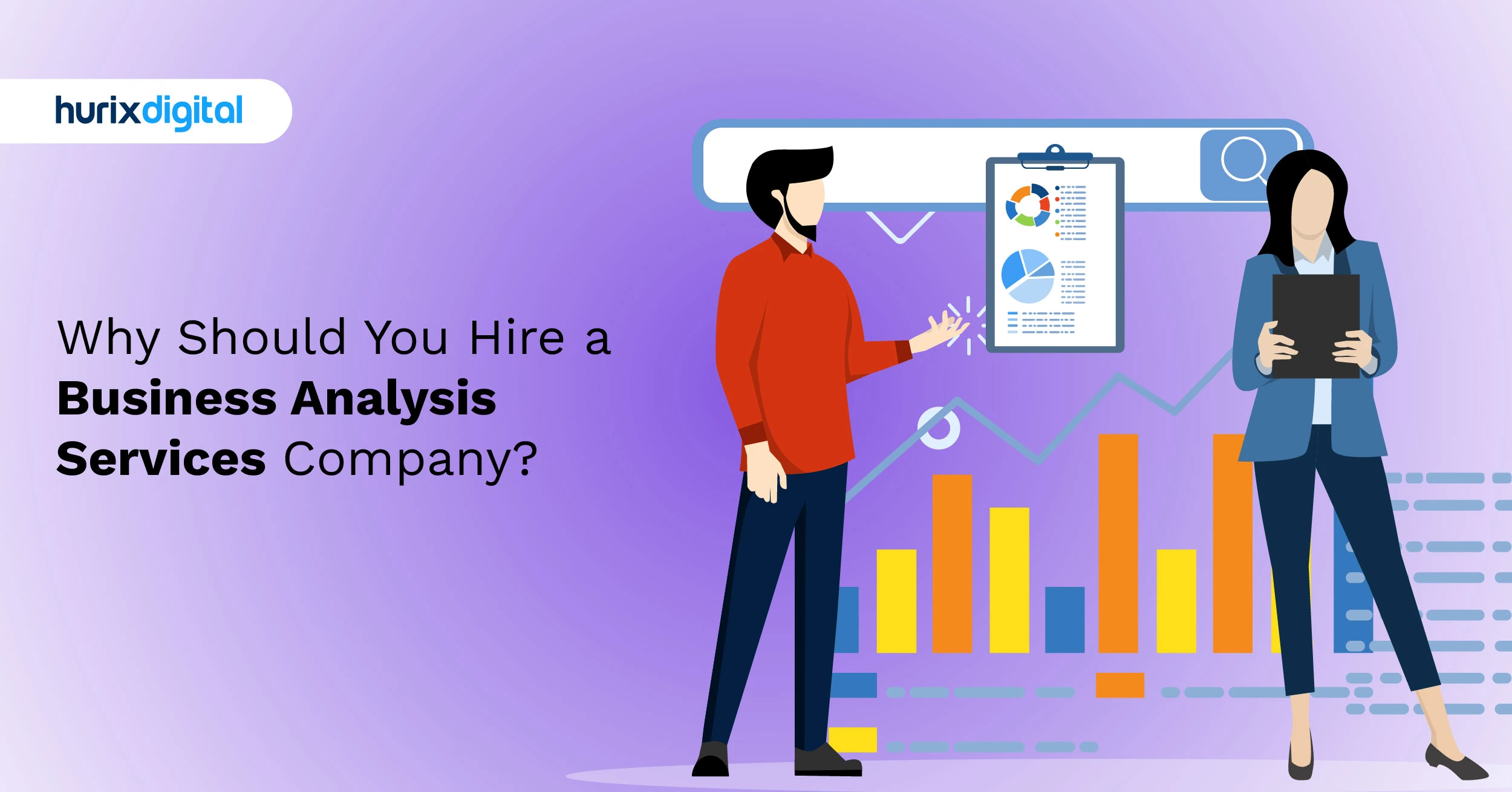
Why Should You Hire a Business Analysis Services Company?
Summarize with:
Business analysis is the enterprise of grasping market trends and initiating changes required in the organization. It is also responsible for designing solutions that would address these changes and deliver value to the company.
Industries are evolving by leaps and bounds. Hence, it becomes crucial to have a department that can articulate the needs of a company to meet the changes head-on.
Enterprises benefit the most when they have a dedicated department for business analysis. In 2022, the big data and business analytics revenue globally stands at $274.3 billion. Companies that cannot spend resources on a dedicated business analytics department tend to outsource it to a renowned business analysis services company.
How do business analysts identify the needs of a company? They study the current performance of the organization. They observe how tasks are managed and delivered by the employees.
If there are better and more efficient ways of handling responsibilities, business analysts offer an alternative solution. Thus, a business analyst is an indispensable asset in organizations.
Table of Contents:
- Defining Business Analytics
- Why are Business Analytics and Analysis Critical to Businesses?
- 5 Business Analysis Techniques
- 4 Business Analytics Tools
- Who is a Business Analyst?
- Why Does Your Business Need a Business Analyst?
- Do You Need Business Analysis Consulting?
- How to Implement Business Analysis Services in Your Organization?
- Services Provided by Business Analysis Services Companies
- Hiring a Business Analysis Services Company
Defining Business Analytics
Companies trade in billions of gigabytes of data, and it is virtually impossible for individuals to manually navigate this web of data to recommend changes and solutions. Hence, enterprises use tools to gain insights into management for business analysis. These tools are called business analytics.
Business analytics tools sort, interpret, and analyze data. Business goals and decisions are then enforced based on quantitative reports, concrete numbers, and statistics. Thus, business analytics shapes the operation strategy to improve performance efficiency, offer solutions, and track process improvements.
Business analytics is the best amalgamation of the management and IT worlds. It implements a thorough understanding of business processes with data, statistics, and analysis.
Why are Business Analytics and Analysis Critical to Businesses?
Competition among enterprises in this age of start-ups is fierce. Businesses must re-evaluate their operations, processes, and ethics. This evaluation can help companies refine their approaches and thrive in the industry. Business analysts provide this analysis on an organizational level.
- Business analysts study the existing business objectives and methodologies to identify where the company is losing resources. Accordingly, they offer solutions to enhance resource management, decrease expenses, accelerate work processes, and increase revenue.
- Management teams cannot work with raw data. They need a clear understanding of the situation to instruct their teams. Business analytics are tools that convert intangible observations into quantitative information to enhance insights and provide actionable instructions.
Business analysis thus provides advanced solutions to address business demands and overcome challenges. Consequently, enterprises are becoming more dependent on business analytics for their solutions.

5 Business Analysis Techniques
Business analysis techniques are operations that help identify business demands and frame solutions to address them. Let’s discuss five techniques in detail:
1. SWOT
Internal and external factors direct business decisions. SWOT analysis, which stands for strengths, weaknesses, opportunities, and threats, interprets both these factors. Strengths and weaknesses affect business models internally, while opportunities and threats are external determiners. Thus, SWOT is a holistic approach to business analysis.
2. PESTLE
PESTLE analysis has six elements: political, economic, social, technological, legal, and environmental. This approach studies the present areas of improvement in the business operations based on these factors and how they affect the company’s growth.
3. MOST
MOST (mission, objectives, strategy, and tactics) is a widely used business analysis technique. You can get a complete overview of an enterprise through MOST analysis. In this technique, business analysts draw detailed strategies and tactics that employees can follow to meet the larger goals of the brand.
4. Business Process Modelling
Business analysts study current processes to identify their shortcomings. Once they locate the gaps, they invent solutions to improve the processes and fulfill the business demands. Business process modeling focuses on improving processes. The workflow of a typical BPM analysis contains processes (analyzing present operations), decisions (defining the necessary changes), and information (relaying the instructions to the management departments).
5. CATWOE
Business decisions affect every stakeholder associated with the enterprise. Thus, business analysts consider the interests of all parties while analyzing business objectives and suggesting changes. This can be achieved through the CATWOE analysis, which stands for customers, actors, transformation process, worldview, owner, and environmental constraints.
4 Business Analytics Tools
Companies use business analytics tools to hasten the data interpretation process. Here, we will look at the top four business analytics software:
1. HubSpot
This platform has built-in analytics tools for sales and marketing. The dashboard and other features allow business analysts to study and analyze the vast marketing data of the entire company at one location.
2. Xplenty
This is a cloud-operated business analytics tool. Xplenty can be used by non-technical professionals. It offers data-driven solutions for marketing, sales, and other process developments by analyzing incoherent raw data.
3. Oracle NetSuite
This is another business management software suitable for non-coders. It sorts through data and provides reports on business analysis.
4. Creation
This platform is catered to larger organizations. It is a low-coding business analytics software. This platform implements features like customer relationship management and process automation for business analysts and customers to communicate and collaborate. Business analysts can also build applications for their enterprises on this tool.
Who is a Business Analyst?
A business analyst (BA) is a professional who bridges the gap between information technology (IT) and business by utilizing data analytics to evaluate various processes and provide data-driven recommendations to executives and other stakeholders.
Involved in various problem-solving techniques, BAs employ a range of statistical and interpersonal skills, such as SQL and visualization tools, such as Tableau, Excel, in a business setting.
Why Does Your Business Need a Business Analyst?
Some of the top reasons why your business needs business analyst services are:
1. Performing Feasibility Studies
BAs can be instrumental in conducting feasibility studies for an organization. A feasibility study is primarily a process of determining whether the potential idea of a project/system is feasible or not.
For instance, by performing a feasibility study, BAs ensure that a project is technically/legally/economically feasible. With this study, BAs also aim to systematically and objectively assess as well as identify both the strengths and weaknesses of an existing business or proposed idea.
By conducting feasibility studies, business analysts also ensure that your organization gets the benefit of:
- Identifying new opportunities
- Improving project teams’ focus
- Narrowing down the business alternatives
- Offering valuable information for a go/no-go project decision
- Identifying a genuine reason to undertake the project
- Enabling decision-making on the project
- Enhancing the success rate by evaluating multiple parameters
2. Performing Risk Assessments and Preparing a Mitigation Plan
Risk assessment is one area that businesses use to spot areas of uncertainty that could affect value. The process of risk assessment helps in the analysis of those uncertainties, along with developing and managing the associated risks.
One of the key focus areas of a business analyst’s job description when working for an organization is to understand such risks associated with a project, assess them, and properly manage them by preparing a mitigation plan to help support project success.
If BAs determine that adequate controls have not been implemented, they develop plans to mitigate, avoid, or modify these risks.
Additionally, business analysts ensure that risk management is performed regularly throughout the project’s lifecycle. To ensure this, they work in collaboration with various stakeholders to help identify new risks and constantly monitor identified risks.
3. Identifying and Defining New Business Opportunities
Identifying business needs and defining new business opportunities is another critical business analyst skill that can do wonders for your organization. The several ways they do this are:
- Conducting market research or identifying new business opportunities brought about by the actions of a vendor/competitor
- Deriving the opportunity from a strategic goal or initiative of the organization
- Identifying a requirement or an opportunity from a complaint made by a business user about an existing system issue, and/or performing a subsequent root cause analysis
- Deriving an opportunity from an enterprise analysis activity, such as SWOT Analysis, Capability Gap Analysis, or Product Feasibility Analysis
4. Writing a Detailed Business Case
Business analysts’ job also involves writing a detailed business case for your organization. It primarily outlines an opportunity as well as a recommendation to invest the business resources and how to take advantage of it.
Put simply, the business case written by a BA acts as a marketing or sales brochure for the business/project idea. The primary purpose of a detailed business case is to sell a viable solution for an identified/defined business problem or new product to the company.
Some of the ways writing a business case can help your organization include:
- Offering insights into the viability of your project, solution, or idea
- Prioritizing projects
- Supporting a feasibility study
5. Act as a Communication Bridge Between Different Stakeholders
A business analyst serves as the communication bridge between the various stakeholders involved, including the business users and the technical IT people.
Apart from contributing significantly to the success of IT projects in your organization, there are several other benefits of having a dedicated business analyst, as they:
- Prepare detailed reports on project scoping, planning, as well as management in terms of both costs and schedule
- Deliver a clear scope of a project from a business perspective
- Elicit the real business requirements of users and effectively manage the expectations
- Improve the overall quality of design for the proposed IT system in a way that meets the user requirements
6. Strategizing
BAs in an organization are also responsible for strategizing and creating new models that support key business decisions. They achieve this by collaborating and working closely with different teams, including financial reporting and IT teams, to establish a range of initiatives and strategies aimed at improving processes and optimizing costs.
To be able to achieve this, BAs display a strong understanding of both regulatory and reporting requirements, along with experience in areas such as budgeting, forecasting, and financial analysis, coupled with an understanding of key performance indicators.
Do You Need Business Analysis Consulting?
Business analysis consulting can be a valuable tool for businesses of all sizes. By providing expert guidance and support, these services can help enterprises identify and address problems early on, before they become larger issues. This can save businesses time and money, and it can also help them improve their overall performance.
Additionally, business analysis consulting services can help businesses improve their marketing strategy, product design, and financial planning. So if you’re looking for a way to improve your business’s performance, collaborating with a business analysis consulting provider is the best decision to make.
How to Implement Business Analysis Services in Your Organization?
Evaluating your organization’s needs and readiness: Assessing your organization’s requirements and understanding the specific areas where BAaaS can add value is crucial before engaging with a service provider.
- Selecting the Right Business Analysis Services Provider: Consider factors such as industry expertise, track record, reputation, and cultural fit when choosing a BAaaS provider.
- Setting Clear Objectives and Expectations: Clearly define the goals and deliverables for the BAaaS engagement to align the provider’s efforts with your organization’s strategic objectives.
- Establishing Effective Communication Channels: Establish open and transparent communication channels with the BAaaS provider to ensure a smooth flow of information and collaboration.
- Integrating Business Analysis Services Seamlessly: Integrate business analysis services into existing business processes to ensure their effectiveness and enable seamless knowledge transfer.
Services Provided by Business Analysis Services Companies
Each business analysis consultancy provides a plethora of services to help businesses identify and solve all business-related problems.
The following is a detailed description of the services provided by business analysis services providers:
1. Regular Maintenance and Upkeep
Running a successful business requires ongoing maintenance and upkeep. Somedays, you might face issues like high technological solutions costs, dashboard malfunctioning, slow workflow, business operations failure, etc.
In such situations, your hired business analysis consultancy service will step in and correct the flaw as soon as possible. They will also strive to put improved processes in place to avoid such problems in the future.
2. Analytical Planning and Strategizing
Each business needs proper planning and strategizing to be able to identify the goals and work towards achieving them. With a consultancy service, you can do analytical planning objectively without any internal biases and restraints.
Additionally, with proper planning and analysis, you will also be able to recognize the overall scope of the business and develop a plan to execute the analysis.
3. Developing New Enterprise Architecture
You might also need a new enterprise architecture to complement the new processes and strategies.
Enterprise architecture primarily encompasses four major domains: business architecture, application architecture, data architecture, and technological architecture. All these domains will enhance your performance and pave the way to IT modernization.
4. Gathering the Right Resources
Various functional and non-functional requirements arise during the business analysis and strategy implementation process. For instance, you might need documentation like business registration papers, tax invoices, etc.
A consultancy service will help you fulfill all the requirements and gather all the necessary information.
5. Analytical Process Designing
The analytical process design involves identifying the gaps and developing a new process to optimize the performance.
Sometimes, instead of designing a new process altogether, consultancy services also redesign existing workflows to fix the loopholes and problematic areas.
6. Implementation of the New Design
Once the new processes and workflows have been designed, the staff is trained accordingly to implement and deploy them the right way.
Often, new technological needs also arise related to the new design. Office policies and procedures might also need to be changed to accommodate the new design.
7. Data Analysis and Reporting
Data is the new currency, and businesses often fail to leverage it the right way. Consultancy services can help you implement a more data-driven culture and make more informed and effective business decisions.
Data-driven culture requires various processes like data gathering, data analysis, reporting, automation testing, and more. To leverage data the right way, the right technology must be selected, and staff must also be trained.
8. Compliance with New Regulations
With the implementation of new procedures and strategies, the regulatory and compliance requirements will also change.
After adopting the new processes, the consultancy services will also help your business adapt to the new regulations. This includes new auditing schedules, risk management, tax filing, payroll management, etc.
If you face any problem while adapting to these regulations, they will help you overcome the challenges and retain efficiency.
Hiring a Business Analysis Services Company
Business analysts work to locate needs for change, draft strategies to deliver the goals and objectives, and work closely with management teams to define efficiency and design solutions to drive the company’s growth.
However, start-ups often struggle to secure funds for a standalone business analysis department. Since business analytics is integral to a successful business enterprise, entrepreneurs might have to go through severe budget cuts.
External business analysis services companies like Hurix Digital are a refreshing solution to this conundrum. To onboard the best business analysis services for your upcoming projects, Hurix Digital is equipped to partner with you to find the right business analyst for the job.
Hurix Digital analyzes your business requirements and converts them into actionable insights. We help organizations realize their goals and improve their processes through business analysis consultancy services. To learn more, visit us here!
Summarize with:

Chief Learning & Innovation Officer –
Learning Strategy & Design at Hurix Digital, with 20+ years in instructional design and digital learning. She leads AI‑driven, evidence-based learning solutions across K‑12, higher ed, and corporate sectors. A thought leader and speaker at events like Learning Dev Camp and SXSW EDU
 A Space for Thoughtful
A Space for Thoughtful 